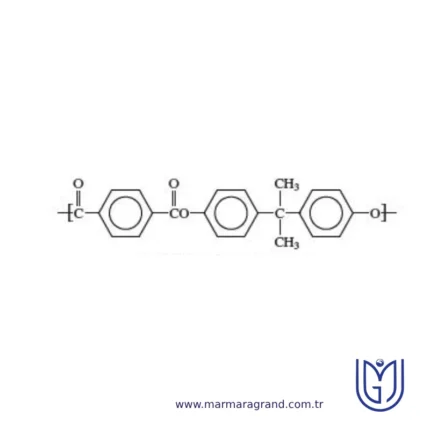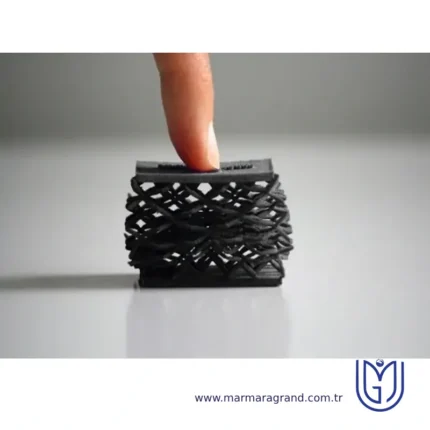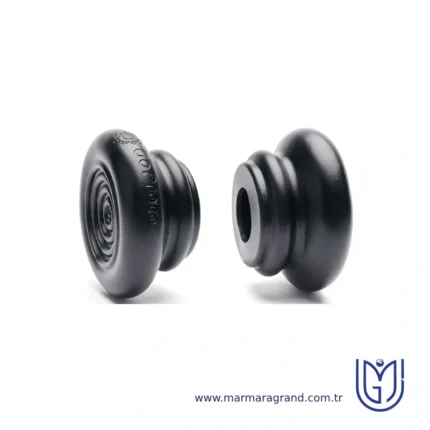Polyamide-imide (PAI)
Polyamide-imide (PAI) is a high-performance thermoplastic known for its exceptional mechanical, thermal, and chemical resistance properties. It is commonly used in demanding applications requiring strength, wear resistance, and high-temperature stability.
Structure
Polyamide-imide (PAI) is a high-performance thermoplastic polymer characterized by the presence of both amide (-CONH-) and imide (-CO-N-CO-) functional groups in its molecular backbone. The structure consists of aromatic rings connected by these amide and imide linkages, which contribute to its exceptional thermal and mechanical properties. The aromatic nature of PAI enhances rigidity and stability, while the amide groups provide flexibility and processability. The imide groups, known for their high thermal resistance, contribute to PAI’s ability to withstand extreme temperatures without significant degradation. This unique combination of structural elements results in a polymer that exhibits excellent strength, wear resistance, and chemical stability, making it ideal for demanding industrial applications.
Properties
Polyamide-imide (PAI) exhibits a unique combination of high mechanical strength, excellent thermal stability, and outstanding wear resistance, making it one of the most durable engineering thermoplastics. It maintains its mechanical integrity at elevated temperatures, with a continuous service temperature of up to 260°C and short-term exposure tolerances even higher. PAI has exceptional resistance to wear, friction, and creep, allowing it to perform reliably in high-load and high-speed applications. Its chemical resistance is superior, withstanding exposure to most solvents, fuels, and acids. Additionally, PAI demonstrates excellent electrical insulating properties, ensuring stability in electrical and electronic applications. With low thermal expansion and high dimensional stability, it retains its shape and structural performance under extreme conditions. These properties make PAI an ideal choice for aerospace, automotive, industrial, and electronic applications where strength, heat resistance, and durability are critical.
Applications of Polyamide-Imide (PAI):
- Aerospace & Automotive: High-performance bearings, bushings, seals, thrust washers, and gears.
- Industrial Equipment: Pump components, compressor vanes, and wear-resistant parts.
- Oil & Gas Industry: Components for high-pressure and high-temperature environments.
- Electronics & Electrical: High-temperature insulators, connectors, and semiconductor components.
- Medical Devices: Sterilization-resistant parts used in surgical instruments.
- Textile & Printing Industry: Rollers, guides, and wear-resistant coatings.
- High Temperature Resistance: Can operate continuously at temperatures up to 260°C (500°F).
- Exceptional Wear & Friction Resistance: Ideal for applications requiring durability and longevity.
- High Mechanical Strength & Stiffness: Retains its structural integrity under heavy loads.
- Good Chemical Resistance: Withstands exposure to fuels, solvents, and acids.
- Excellent Electrical Insulation Properties: Performs well in high-temperature electrical applications.
- Dimensional Stability: Low thermal expansion and minimal deformation under stress.
- High Cost: More expensive than conventional engineering plastics.
- Difficult to Process: Requires specialized molding or machining techniques due to its high melting point.
- Hygroscopic Nature: Absorbs moisture, which can affect dimensional stability in humid environments.
Polyarylate (PAR)
Polyarylate (PAR) is a type of high-performance aromatic polyester known for its excellent thermal stability, mechanical strength, and resistance to chemicals and UV radiation. It is commonly used in engineering applications where durability and heat resistance are required.
Structure
Polyarylate (PAR) is a high-performance thermoplastic polymer composed of repeating aromatic ester units in its backbone. Its structure consists of aromatic rings (benzene) connected by ester (-COO-) linkages, giving it excellent thermal and mechanical properties. The presence of these rigid benzene rings enhances the polymer’s strength, dimensional stability, and resistance to heat and UV radiation. Unlike aliphatic polyesters, which have flexible carbon chains, the rigid aromatic backbone of polyarylates prevents easy molecular rotation, making the material more heat-resistant and mechanically robust. A common type of polyarylate is based on bisphenol A (BPA) and terephthalic or isophthalic acid, forming a polymer with a high glass transition temperature and excellent durability. This unique structure makes polyarylates ideal for applications requiring transparency, heat resistance, and chemical stability, such as optical lenses, automotive parts, and electronic components.
Properties
Polyarylate (PAR) exhibits a combination of high thermal stability, mechanical strength, and chemical resistance, making it a valuable engineering thermoplastic. It has a high glass transition temperature (Tg) of around 180°C, allowing it to retain its shape and strength under elevated temperatures. Its excellent mechanical properties, including high tensile strength and toughness, make it resistant to wear and impact. Additionally, PAR has outstanding UV and weather resistance, preventing degradation when exposed to sunlight, making it suitable for outdoor applications. The polymer is also chemically resistant to oils, acids, and solvents, ensuring durability in harsh environments. Many grades of polyarylate are optically transparent, making them useful for lenses and display applications. Furthermore, it exhibits good dimensional stability and low creep, ensuring reliability in precision applications like electronic components and automotive parts. These properties collectively make PAR an ideal material for high-performance applications where strength, heat resistance, and durability are essential.
Applications of Polyarylate (PAR):
- Electronics & Electrical Components – Used in connectors, insulators, and circuit boards due to its heat and electrical resistance.
- Automotive Parts – Ideal for components exposed to high temperatures and mechanical stress.
- Aerospace Industry – Used in structural components for its lightweight and high durability.
- Optical Lenses & Displays – Some grades are optically clear, making them suitable for eyewear, camera lenses, and LCD panels.
- Medical Devices – Resistant to sterilization methods and biocompatible for certain medical applications.
- Industrial Machinery – Used in gears, seals, and mechanical components requiring high strength and wear resistance.
- Consumer Goods – Found in high-end cookware, protective coatings, and UV-resistant outdoor products.
- High heat resistance – Maintains strength at elevated temperatures.
- Excellent mechanical strength – High tensile strength and impact resistance.
- UV and weather resistance – Ideal for outdoor applications without degradation.
- Good chemical resistance – Withstands exposure to oils, acids, and solvents.
- Optical clarity – Some grades are transparent, useful for lenses and displays.
- Dimensional stability – Low creep and high rigidity for precision applications.
- Expensive – Higher cost compared to conventional plastics.
- Difficult processing – Requires specialized equipment and high processing temperatures.
- Brittle in some conditions – May be prone to stress cracking under certain loads.
- Limited availability – Less commonly used than other engineering plastics, leading to fewer commercial grades.
Thermoplastic PolyAmide elastomer (TPA)
Thermoplastic Polyamide Elastomer (TPA) is a type of thermoplastic elastomer (TPE) that combines the flexibility and elasticity of elastomers with the strength and processability of thermoplastics. TPAs are composed of alternating soft and hard segments, where the soft segments provide elasticity, while the hard segments (typically polyamide-based) contribute to mechanical strength and thermal stability.
StructureThe structure of Thermoplastic Polyamide Elastomer (TPA) consists of a phase-separated morphology with alternating soft and hard segments. The soft segments are typically composed of polyether or polyester chains, which provide flexibility, elasticity, and low-temperature performance. The hard segments are derived from polyamide (nylon) components, contributing to mechanical strength, chemical resistance, and thermal stability. This block copolymer structure allows TPAs to exhibit both rubber-like elasticity and thermoplastic processability. The hard polyamide domains act as physical crosslinks, reinforcing the material and providing shape stability, while the soft segments allow for stretchability and energy absorption. This unique microstructure enables TPAs to maintain excellent mechanical properties while being reprocessable and recyclable like conventional thermoplastics.
PropertiesThermoplastic Polyamide Elastomer (TPA) exhibits a unique combination of flexibility, strength, and chemical resistance, making it a highly versatile material. It possesses high elasticity and excellent recovery, allowing it to behave like rubber while maintaining thermoplastic processability. TPAs offer superior mechanical strength, abrasion resistance, and durability, making them suitable for demanding applications. They also demonstrate outstanding chemical and oil resistance, particularly against fuels, solvents, and industrial chemicals, which enhances their performance in harsh environments. Additionally, TPAs have good thermal stability, allowing them to withstand a wide range of temperatures without significant degradation. However, due to their hygroscopic nature, they tend to absorb moisture from the environment, requiring proper drying before processing. Despite this, their lightweight nature, recyclability, and ease of processing through standard thermoplastic methods such as injection molding and extrusion make TPAs an attractive choice for various industries, including automotive, electronics, and medical applications.
Applications of TPA
- Automotive: Fuel lines, air ducts, seals, gaskets, and hoses.
- Electronics: Wire insulation, connectors, and protective casings.
- Medical Devices: Tubing, catheters, flexible components, and grips.
- Industrial Machinery: Conveyor belts, seals, vibration dampeners, and flexible couplings.
- Sports & Consumer Goods: Shoe soles, flexible grips, protective gear, and wear-resistant textiles.
Advantages of TPAHigh chemical and oil resistance – Withstands fuels, solvents, and industrial chemicals. Excellent mechanical strength – Offers toughness, durability, and abrasion resistance. Good flexibility and elasticity – Provides rubber-like properties with thermoplastic processing benefits. Wide temperature range stability – Performs well in both high and low temperatures. Lightweight and recyclable – More sustainable compared to traditional rubber. Easy processing – Can be injection molded, extruded, or blow molded.
Disadvantages of TPAHigher cost – More expensive than standard thermoplastic elastomers (TPEs). Hygroscopic nature – Absorbs moisture, requiring drying before processing. Lower flexibility than fully vulcanized rubber – May not match the elasticity of certain elastomers. Limited UV resistance – Some grades may require UV stabilizers for outdoor applications.











